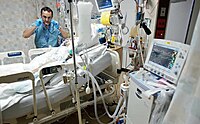
Photo from wikipedia
In this interesting retrospective study, the authors correlate severity scores in computed tomography lung scans with the nasopharyngeal viral load as well as further laboratory data in 37 patients suffering… Click to show full abstract
In this interesting retrospective study, the authors correlate severity scores in computed tomography lung scans with the nasopharyngeal viral load as well as further laboratory data in 37 patients suffering from COVID-19. In their study, the authors divided patients into nonseverely ill and severely ill patients. The authors classified the severity of the participants' disease as follows: (1) a mildly ill group, in which patients exhibited mild clinical symptoms and no imaging manifestations of pneumonia; (2) a moderately ill group, in which patients had a fever and respiratory symptoms, and signs of pneumonia were observed in imaging; (3) a severely ill group, in patients exhibited dyspnea, a respiratory rate ≥ 30 breaths/min, oxygen saturation (SpO2) ≤93% at a resting state, or arterial partial pressure of oxygen/oxygen concentration (FiO2) ≤300 mm Hg; pulmonary imaging showed marked lesion progression >50%within 24–48 h; (4) a critically ill group, in which patients who had any of the following symptoms had to be admitted to the intensive care unit: respiratory failure and requiringmechanical ventilation, or shock combined with the failure of other organs. Patients who were severely and critically ill were labeled “severely ill patients,” while mildly/moderately ill patients were defined as “not severely ill patients.” Classification of chest computed tomography (CT) severity was primarily based on the invasion range and morphological characteristics of lesions as follows: CT-1, ground glass opacities (GGO) in ≤25% of the lung parenchyma; CT-2, GGO in 26%–50% of the lung parenchyma; CT-3, GGOand consolidation in 51%–75% of the lung parenchyma; CT-4, GGO and consolidation in ≥76% of the lung parenchyma. The extent of lesions in each lung lobewas evaluated applying a score ranging from0 to4. A summation of the scores from all five lobes provided the total CT severity score ranging from 0 to 20. In this context, it should be noted that it remains unclear if dedicated reconstructions such as minimum intensity projection series were applied, since these reconstructions can significantly improve the visualization and detection of GGO compared to standard CT reconstructions, particularly in the initial period of disease. The idea to correlate CT severity scores with clinical and laboratory data is not new, however, there are only few studies evaluating correlation in the context of dynamic disease progression. The results show that in the case of COVID-19 progression nasopharyngeal viral load and lung CT severity were closely related, and lung CT severity negatively correlatedwith lymphocyte andmononuclear cell counts, as well as cycle threshold (Ct) values of largely coronavirus-expressed genes. Among severely ill COVID-19 patients, the Ct value was negatively related to CRP and CT severity but did not correlate with lymphocyte, mononuclear cell, neutrophil counts, procalcitonin, and length of hospital stay. The authors concluded that an increased viral load and CRPwere associated with increased lung inflammation, which has been demonstrated by studies in the literature. When the severity of the disease progressed, lymphocyte counts decreased but no statistical correlationwas observed between lymphocyte counts and Ct values. The results also showed that CT severity negatively correlated with lymphocyte and mononuclear cell counts. At the critical stage, both viral infection and inflammatory factors are involved in lung inflammation, and corresponding treatment strategies should be adopted to avoid the occurrence of cytokine storm and the development of ARDS in patients. The authors concluded that by closely monitoring CT, clinical, and laboratory indicators, early intervention measures should be taken to reduce the occurrence of mortality. We fully agree with this hypothesis, however, some questions remain regarding the value of CT imaging COVID-19. What is the clinical benefit of CT scanning of the lungs in patients compared to patients only having clinical and laboratory data? Obviously, CT angiography should be performed to exclude complications such as pulmonary embolism or bleeding. However, which is the Received: 1 December 2021 Accepted: 2 December 2021
Journal Title: Journal of Clinical Ultrasound
Year Published: 2022
Link to full text (if available)
Share on Social Media: Sign Up to like & get
recommendations!